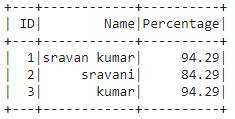将Python字典列表转换为 PySpark DataFrame
在本文中,我们将讨论如何将Python Dictionary List 转换为 Pyspark DataFrame。
可以通过以下方式完成:
- 使用推断模式。
- 使用显式模式
- 使用 SQL 表达式
方法一:从字典中推断模式
我们将字典直接传递给 createDataFrame() 方法。
Syntax: spark.createDataFrame(data)
示例:使用此方法从字典列表创建 pyspark 数据框的Python代码
Python3
# import the modules
from pyspark.sql import SparkSession
# Create Spark session app name
# is GFG and master name is local
spark = SparkSession.builder.appName("GFG").master("local") .getOrCreate()
# dictionary list of college data
data = [{"Name": 'sravan kumar',
"ID": 1,
"Percentage": 94.29},
{"Name": 'sravani',
"ID": 2,
"Percentage": 84.29},
{"Name": 'kumar',
"ID": 3,
"Percentage": 94.29}
]
# Create data frame from dictionary list
df = spark.createDataFrame(data)
# display
df.show()Python3
# import the modules
from pyspark.sql import SparkSession
from pyspark.sql.types import StructField, StructType,
StringType, IntegerType, FloatType
# Create Spark session app name is
# GFG and master name is local
spark = SparkSession.builder.appName("GFG").master("local") .getOrCreate()
# dictionary list of college data
data = [{"Name": 'sravan kumar',
"ID": 1,
"Percentage": 94.29},
{"Name": 'sravani',
"ID": 2,
"Percentage": 84.29},
{"Name": 'kumar',
"ID": 3,
"Percentage": 94.29}
]
# specify the schema
schema = StructType([
StructField('Name', StringType(), False),
StructField('ID', IntegerType(), False),
StructField('Percentage', FloatType(), True)
])
# Create data frame from
# dictionary list through the schema
df = spark.createDataFrame(data, schema)
# display
df.show()Python3
# import the modules
from pyspark.sql import SparkSession, Row
# Create Spark session app name
# is GFG and master name is local
spark = SparkSession.builder.appName("GFG").master("local") .getOrCreate()
# dictionary list of college data
data = [{"Name": 'sravan kumar',
"ID": 1,
"Percentage": 94.29},
{"Name": 'sravani',
"ID": 2,
"Percentage": 84.29},
{"Name": 'kumar',
"ID": 3,
"Percentage": 94.29}
]
# create dataframe using sql expression
dataframe = spark.createDataFrame([Row(**variable)
for variable in data])
dataframe.show()输出:

方法 2:使用显式架构
在这里,我们将创建一个架构并将架构与数据一起传递给 createdataframe() 方法。
架构结构:
schema = StructType([
StructField(‘column_1’, DataType(), False),
StructField(‘column_2’, DataType(), False)])
其中列是要在 pyspark 数据框中获取的字典列的名称,而 Datatype 是特定列的数据类型。
Syntax: spark.createDataFrame(data, schema)
Where,
- data is the dictionary list
- schema is the schema of the dataframe
使用此方法从字典列表创建 pyspark 数据框的Python程序。
蟒蛇3
# import the modules
from pyspark.sql import SparkSession
from pyspark.sql.types import StructField, StructType,
StringType, IntegerType, FloatType
# Create Spark session app name is
# GFG and master name is local
spark = SparkSession.builder.appName("GFG").master("local") .getOrCreate()
# dictionary list of college data
data = [{"Name": 'sravan kumar',
"ID": 1,
"Percentage": 94.29},
{"Name": 'sravani',
"ID": 2,
"Percentage": 84.29},
{"Name": 'kumar',
"ID": 3,
"Percentage": 94.29}
]
# specify the schema
schema = StructType([
StructField('Name', StringType(), False),
StructField('ID', IntegerType(), False),
StructField('Percentage', FloatType(), True)
])
# Create data frame from
# dictionary list through the schema
df = spark.createDataFrame(data, schema)
# display
df.show()
输出:

方法 3:使用 SQL 表达式
这里我们使用 Row函数将Python字典列表转换为 pyspark 数据帧。
Syntax: spark.createDataFrame([Row(**iterator) for iterator in data])
where:
- createDataFrame() is the method to create the dataframe
- Row(**iterator) to iterate the dictionary list.
- data is the dictionary list
将字典列表转换为 pyspark 数据框的Python代码。
蟒蛇3
# import the modules
from pyspark.sql import SparkSession, Row
# Create Spark session app name
# is GFG and master name is local
spark = SparkSession.builder.appName("GFG").master("local") .getOrCreate()
# dictionary list of college data
data = [{"Name": 'sravan kumar',
"ID": 1,
"Percentage": 94.29},
{"Name": 'sravani',
"ID": 2,
"Percentage": 84.29},
{"Name": 'kumar',
"ID": 3,
"Percentage": 94.29}
]
# create dataframe using sql expression
dataframe = spark.createDataFrame([Row(**variable)
for variable in data])
dataframe.show()
输出:
